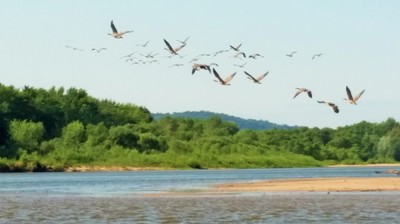“The Round River, a river that flowed into itself, and thus sped around and around in a never-ending circuit” -- Aldo Leopold, “The Round River”
On any given summer’s day—and they are all “given”—there are numerous locations from which to launch a canoe or kayak for a day-trip on the lower reaches of the Wisconsin River.
You can spend a weekend watching outdoor theater at Spring Green, then hop in the canoe near Tower Hill State Park and take out at Muscoda, where, if you time your trip for late May you can join in on the annual Morel Mushroom Festival. You can float to the mouth of the Wisconsin and recreate the 1673 canoe journey of Fr. Jacques Marquette and Louis Joliet, whose crew were the first Europeans to navigate into the Mississippi River.
But for reasons of easy access and favorite scenery, my wife and I have returned again and again each summer to a stretch of Wisconsin river in between these locations, embarking at Boscobel and taking out nine miles downstream at Woodman. When we are by ourselves, I toss my old bicycle into the canoe, and shuttle back to Boscobel to get the car, completing the loop.
The Wisconsin River offers some of the best canoeing and kayaking in the immediate area. From Sauk Prairie to the Mississippi River, paddlers enjoy 92 miles of dam-free river flowing through the steep bluffs of the Driftless region. Along the way you’ll spot egrets, sandpipers, turkey vultures and bald eagles. In the fall you may find yourself puzzled by the manic laughter of migrating sand cranes.
But the crown jewel of the Wisconsin River is its impeccable sand. Whereas most Midwestern rivers have a muddy bottom and shoreline, the Wisconsin River is underlain and rimmed with a thick coat of rich, clean, tan-colored sand, perfect for squelching between the toes and brushing as a coarse grit from sun-dried skin.
Because on the Wisconsin River, you won’t stay in the canoe all afternoon. Depending on the season and your misjudgments on choosing a flow route, you may have to climb out and walk your canoe across a low spot or two. There will be sand islands where you’ll stop for lunch. (You’ll joke, of course, about the sand that inevitably ends up in your sandwich, adding a bit of crunch.) The water may be cold, but you’ll suck it up and take a life-jacket float through the straits, for the sandy bottom makes this among the clearest waters of the upper Midwest.
This lower stretch of river bisects what conservationist Aldo Leopold called the “sand counties” of southwest Wisconsin. The sand originates from a central lowland that 15,000 years ago formed the bed of the ice-dammed Glacial Lake Wisconsin situated near the retreating edges of the last glaciers. When the ice dam melted and burst, the glacial lake drained quickly, gouging out the Wisconsin Dells and coursing through the Wisconsin River valley and down the Mississippi. When the rush of water slowed, it dropped its load of lake-bottom sand that the glaciers had been grinding up for millennia as they scraped across the up-state bedrock. The result is the sand-rich shores of the Wisconsin River.
Today as you slide over the shallows in a canoe, you can watch the sand still pushing downstream, grain tumbling over grain in the low spots, spilling over underwater ledges into the deeps, endlessly creating and erasing islands.
The constantly streaming sand gives the illusion that the supply must be endless, that it must somehow feed back into itself and flow again downstream.
In his essay “Round River,” Aldo Leopold re-told the old Paul Bunyan legend of a river “that flowed into itself, and thus sped around and around in a never-ending circuit.” In the tall-tale, Bunyan the sawyer floated felled timber down Round River, but even after he finished his work, the water remained plentifully stoked with logs, as the river circled back around floated past again.
Leopold turned the story into a parable about ecosystems. What goes into the river stays in the river and cycles endlessly through the food chains of bass and crane and hawk. A healthy ecosystem sustains itself. A poisoned one retains toxicity.
Conversely, what comes out of the ecosystem stays out. First it was Paul Bunyan’s hardwood forests that disappeared. Along with it went habitat for a wealth of creatures.
Today, ironically, it is the sand counties’ clean, rich sand that is mined and shipped downstream—by rail and barge—for use in fracking operations down south.
The sands of the Wisconsin River are not in danger of entirely floating away or being hauled off by rail. But Leopold’s parable serves as a reminder that whatever damage we do to our environment stays arounds to haunt us later.
I keep a Round River of my own. Nearly every summer I will hit an antsy day and tell my wife, “It’s time to return to the Wisconsin River.” I’ll toss the bike in the canoe alongside the cooler and paddles at Boscobel, we’ll eat our sandwiches on an island, we’ll float and paddle and talk and stay quiet, we’ll pull the canoe from the river at the wooden dock at Woodman.
And I’ll bike back to get the car, completing yet another cycle.
-- Kevin Koch
May 2017




